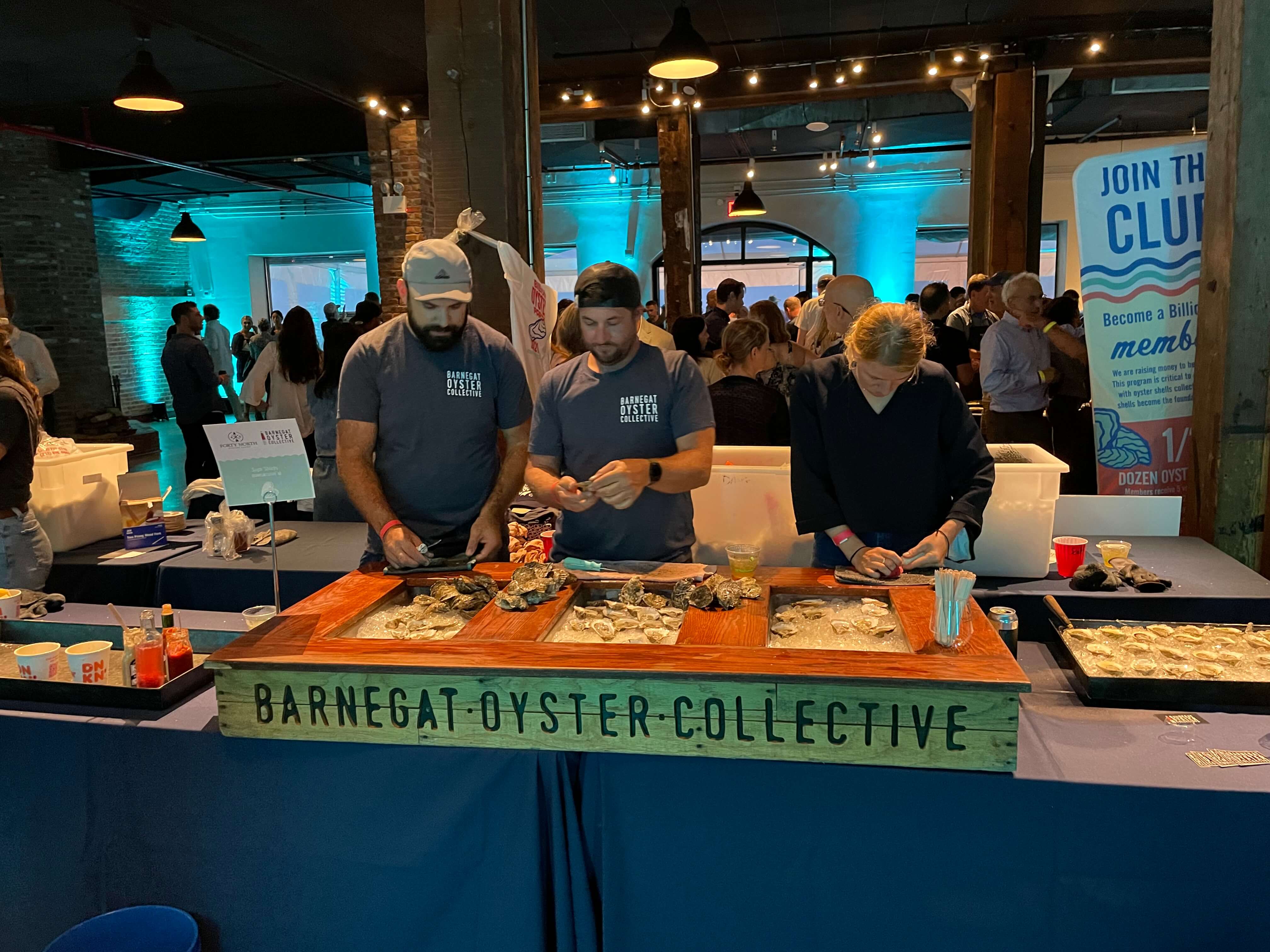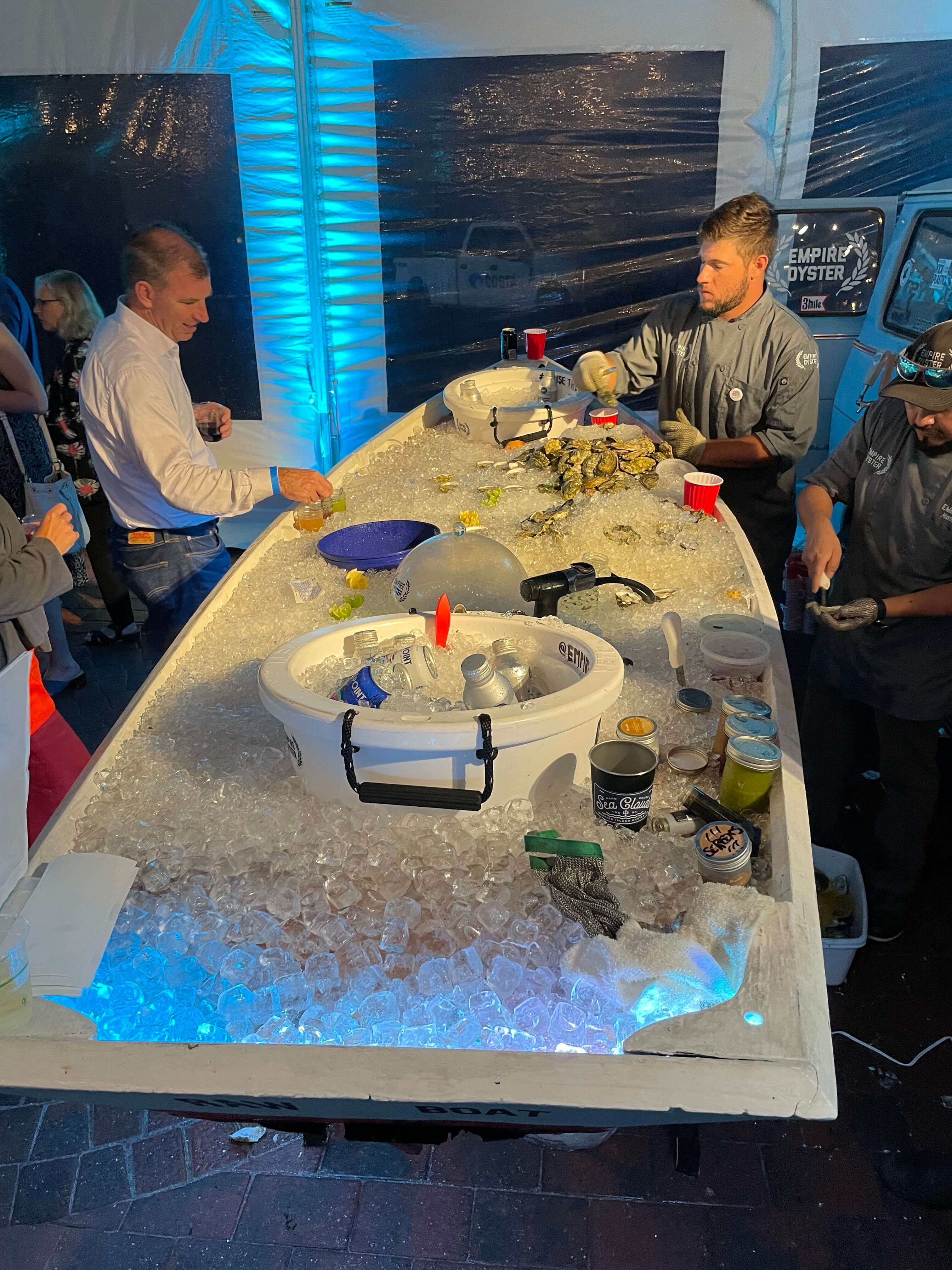The Seventh Annual Billion Oyster Party drew legions of supporters to achieve BOP’s goal of planting one billion oysters across one hundred reefs by 2035 to heal New York Harbor. Is it also creating a novel blue economy?
By Richard Dodd
Guest Contributor, Freelance Writer, and Environmentalist
The Billion Oyster Project (BOP) threw a shucking good party on September 23 that raised over $300,000 in a sold-out event. This seventh annual fundraiser took place at the Liberty Warehouse in the Red Hook section of Brooklyn as over 1000 revelers defied the storm gods that unleashed torrents of rain. Of course, New Yorkers dealt with this minor inconvenience (any inconvenience seems mild after dealing with COVID-19) and partied as only New Yorkers can.
Over a dozen aquaculture farmers from Maine to California offered fresh shucked oysters. The oyster farm branding game was on display and featured colorful names such as Laughing Gull, Lucky 13, Violet Cove, Stormy Bay, Hama Hama, Forty North, Empire Oysters, Cutty Hunk, and East Coast Blonds along with mainstays Fisher Island, Taylor Oyster Farms, and Cape May Salts.
The shellfish serving stations offered lemon slices, horseradish, cocktail sauce, and champagne vinaigrette to pair with the oysters. Purists chose to eat their briny treats au naturel and savor the natural juice called liquor. The oyster farm’s location, water mineral content, algae, and salinity impart a unique flavor profile. Speaking of liquor, multiple open bars offered champagne, wine, scotch, whisky, and beer including Good Reef Ale that was named in honor of BOP’s reef restoration.
What a difference a year makes
Last year the sixth annual Billion Oyster Party was held virtually via Zoom due to the global pandemic. How do you shuck an oyster virtually? It was also a year of financial hardship for oyster farmers on the East Coast who saw their restaurant clients cease indoor dining and curtail oyster purchases.
Fortunately, Pew Charitable Trusts and The Nature Conservancy stepped in to purchase oversized oysters from farmers and repurpose them for environmental restoration. The two-million-dollar buyback program called SOAR (Supporting Oyster Aquaculture and Restoration) procured five million oysters from over one hundred oyster farms. Those oysters are now cleaning New York Harbor as ecosystem engineers and not happy hour table fare.
The Origins of BOP
The Billion Oyster Project was formed in 2014 by our better angels, named Pete Malinowski and Murray Fisher. They had the audacious vision to clean up New York Harbor by planting and growing over a billion oysters by 2035 across 100+ sustainable oyster reefs. Since an adult oyster can filter fifty gallons of water a day, this army of prehistoric creatures – whose origins date back an estimated two million years – would perform a magical form of environmental alchemy. These briny superheroes can not only transform polluted to clean water, but they also create habitat for other marine life; function as a buffer to dampen storm surge (remember Hurricane Sandy) and offer hope to restore our damaged estuary for future generations to enjoy.
Peter and Murray’s Ode to Saving New York Harbor
Cast away fear, cynicism, and doubt,
Summon a billion briny angels to drive pollutants out.
There is more to this story …
The Billion Oyster Project may have created a novel and sustainable blue economy. Say what?
The World Bank’s definition follows: “The Blue Economy is the sustainable use of ocean resources for economic growth, improved livelihood, and jobs while preserving the health of marine and coastal ecosystem.” A closer definition is the term “blue economy” in economics that relates to the exploitation, preservation, and regeneration of the marine environment. These descriptions are a holistic match to the impact of the Billion Oyster Project on New York’s economy and beyond.
The milestone chart that follows explores the economic connecting points served by the Billion Oyster Project that includes shellfish restoration of seventy-five million oysters: over seventy-five restaurants engaged in oyster shell donation; over 1.8 million shells collected; 225 restoration stations deployed; 8,000 students enrolled in educational programs; and over 10,000 volunteers engaged.
The Billion Oyster Project has grown to become one of the largest estuary restoration projects in the United States. The educational reach of this movement has evolved into a center of excellence for citizen-science initiatives around the world. In fact, it is touching the lives of a projected one million students who are being introduced to a world that embraces environmental restoration work to heal our planet. Perhaps a bit of prose and poetry paints the BOP story:
A Partygoer’s Ode to The Billion Oyster Party
The Billion Oyster Party,
On the 23rd day of September.
Welcomed a celebration of the hardy,
This was a Shellabration to remember.
Facing storm clouds and sheets of rain,
Partier’s chose oyster revelry over cancellation pain.
Over 300,000 dollars was raised,
The BOP team and attendees deserve to be praised.
Yes, New York Harbor will be saved,
By the better angels of our nature.
And with a little help from our friends,
The briny angels summoned from nature.
Richard Dodd is a freelance writer, environmentalist, and published author (Betrayal by Blood and Demons under the pen name Ian McBride). He received certification from Rutgers University in the areas of Coastal Stewardship and Shellfish Gardening. He lives in the Princeton area and volunteers to restore our estuaries with the Billion Oyster Project and the Barnegat Bay Partnership.
Richard Dodd
401-O Oxford Lane
Monroe Township, NJ 08831
(646) 245-8315
richdoddwriter@gmail.com











